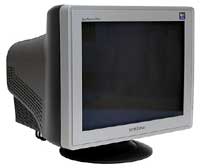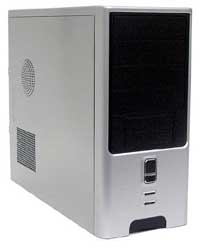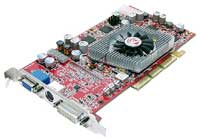AMD Budget Gaming System
If price is your biggest concern, then even $25 for a slightly faster component can be "too much". Such increases add up quickly, and that's what makes this the most difficult price goal to achieve without making compromises. In fact, it really isn't possible to build a "Budget" system that doesn't make some concessions to the almighty dollar. We have done our best, however, to build a system that will be capable of playing all the latest titles at acceptable rates for the next year or two at least. We have a couple of options from the AMD camp as well as one from the Intel side to help you out. We'll start with the absolute cheapest system that we would recommend for gaming, and follow that with a slightly updated system.
| Budget AMD Athlon 64 754 System |
| Hardware |
Recommended Component |
Price |
| Processor |
AMD Athlon 64 2800+ 512K 1.8 GHz (754) |
127 |
| Motherboard |
Chaintech VNF-250 (754) |
73 |
| Memory |
1x512MB Mushkin Basic 2.5-4-4 |
75 |
| Video Card |
Sapphire Radeon 9800 Pro 128 MB 256-bit |
196 |
| Hard Drive |
Seagate Barracuda 80GB EIDE model 7200.7 |
59 |
| Optical Drive |
NEC DVD+/-RW Drive Model 3500A |
72 |
| Case and Power Supply |
Athenatech A602 Black/Silver with 350W PSU |
62 |
| Display |
Samsung 793DF 17 Black/Silver CRT (1280x1024@75 Hz) |
139 |
| Speakers |
Use what you have |
0 |
| Keyboard and Mouse |
Logitech Optical Desktop Combo |
26 |
| Bottom Line |
|
829 |

Click to enlarge. |
The final price comes to a bit more than our $750 target. Unfortunately, it is difficult to get a quality gaming system without making some compromises. We don't include speakers either, on the assumption that most people will have some decent headphones or speakers already available. The same can be said of the monitor: if you already have a monitor with which you are content, you can stick with that for the time being. One nice feature of our Samsung is that it can provide a generally flicker-free 75 Hz refresh rate at its highest 1280x1024 resolution. Unless you need a complete system, those items are the prime candidates for reducing the cost to reach the $750 goal.

Click to enlarge. |
Keyboard and mouse are a personal choice, but we have stuck with the bare minimum for the time being. We prefer Microsoft and Logitech keyboards and mice for a variety of reasons, but they are certainly not the only option; so if your opinion differs from ours, get what you like. The case was one of the more difficult items to select. We like Antec cases for their quality and overall reliability, but there are a huge number of cases from which to choose, so we wanted to give some other options. The Athenatech case comes with a generic 350W PSU, but that will suffice for this configuration. It also has a rear 120mm fan and a cooling duct that sits above the CPU, allowing the HSF to draw in fresh, cool air directly.

Click to enlarge. |
The real core of any gaming system is not the case, speakers and monitor. Those are what others will see, and they may be important from an aesthetic point of view, but if you're only worried about games and you're on a budget, the motherboard, processor, and graphics card are where you want to spend the most money. The socket 754 platform may not have the long-term upgrade options of socket 939, but it does allow us to cut about $50 off the price without sacrificing a whole lot of performance. We have chosen the cheapest Athlon 64 available, the 2800+, which runs at 1.8 GHz. Performance in games is generally better than the Pentium 4 2.8 GHz chips, so the performance rating is deserved. The Sempron 3100+ is also an option that would save us another $20 or so, but we felt that the potential 64-bit enhancements, which should arrive in the next year or so, make it worthwhile, not to mention the larger 512K cache.

Click to enlarge. |
Our choice of graphics card goes to the Radeon 9800 Pro 128 MB. It is important to emphasize that we're looking at the version with a 256-bit memory interface, so make sure you choose the correct model if you want to remain with our selection. There are "9800 Pro" cards now shipping with 128-bit interfaces, and there are also the 9800SE cards that have lower clock speeds and half of the pixel pipelines. For gaming performance, there's almost a linear scaling with the amount of money spent on your graphics card these days. So, if you are willing to turn down some details, you could go with one of the other 9800 variants or even the 9600 Pro or 9600XT, but they are likely to have some issues with upcoming games within the next year or so. For this price bracket, it is also worth mentioning that the 256 MB cards are mostly pointless unless you have a 256-bit memory interface, and that combination tends to cost quite a bit more. If the difference in price between a 128 MB and a 256 MB card is relatively small - i.e. less than $25 - then a card with more RAM might be useful. Otherwise, save your money.
The remainder of the system is pretty much what you've seen us recommend in the past. The 80GB Seagate hard drive comes with a five-year warranty and provides ample storage. Performance differences between the various hard drives really are not that great unless you really spend a lot of money. The DVD+RW drive is our Editor's Choice NEC 3500A from the recent
Fall 16X DVDR Roundup, which provides good performance and features at a very low price. We could have gone with a cheaper optical drive instead of a DVD burner, but we prefer to have a system with CD/DVD burning capability. If you disagree, a DVD-ROM drive can be had for about $25, as can a CD-RW drive. We recommend DVD support for gaming systems, as some of the newer titles are shipping in both DVD and CD versions. Installing from one DVD is much more convenient than installing from four or more CDs, and we can only hope that more games will make the shift to DVDs. We did not include a floppy drive, but for an extra $9, you might want to toss one in just to be safe. There are still some hard drive controllers that require the use of a driver floppy in order to work with the Windows XP installation.














70 Comments
View All Comments
SDA - Wednesday, December 1, 2004 - link
Whoops, I'd forgotten all about this thread.400W is fine if that's what you want, since it's your system. I wouldn't recommend to others that they spend much more for a 400W PSU (as opposed to spending more to get a higher-quality 350W or 380W PSU) when the average high-end Athlon 64 rig consumes 230W or so under load, though. I'd define 50% more than is necessary under full load "moderate," how about you?
520W is still overkill for SLI 6800GTs on an A64, although not as bad as 400W is overkill for the average A64. As I recall, SLI 6800Us on a high-end A64 eat something like 350W of power (decked out with HDDs and fans and whatnot, of course). 470W is perfectly fine there (although I'd personally just get a Tagan 480W, which should be the same and cheaper + less gaudy to boot). Again, you're welcome to do what you want, but you have an obligation to research system power consumption before you make recommendations to others.
As for E-Power/Tagan, the amperages really aren't very different. Furthermore, just because they don't look the same doesn't mean they're not. They use very similar components, have an identical layout, and use the same PCB. Trust me, PCB and components say a lot more than paint job ;) Googling Tagan and PowerStream should give you some nice solid evidence (and juicy internals pics!).
Again, nothing against the guide in general.. I just ask that you research the subject more in the future.
JarredWalton - Friday, November 26, 2004 - link
"Moderate PSU" in my book means >=400W these days. If a 350W generic PSU isn't sufficient, are you really going to want to spend $25 to $30 (shipped) for something that is the same wattage but more reliable? Maybe, but I wouldn't. If I buy an add-in PSU, I'll get at least a 400W.520W *is* overkill for most systems, but if you look at what I said it makes sense. If you want SLI with two 6800 GT or 6800 Ultra cards, you're probably going to have two (or more) hard drives and a lot of other stuff as well. I would spend the extra money for the 520W in that case. Regarding the OCZ = Tagan comment, I would have to see some really concrete evidence of that. Judging by The Egg, they're not the same:
http://www.newegg.com/app/viewProductDesc.asp?desc...
http://www.newegg.com/app/viewproductdesc.asp?desc...
The E-Power/Tagan has very different amperages than the OCZ. The shells are also different. Both are quality power supplies, of course, but even if they share some common components, that doesn't make them "the same."
Anyway, the PSU comments are duly noted and I will make sure to mention this item more clearly in the future. Please move on from the PSU comments now... nothing to see here. ;) (If you really want to comment more on the PSUs, you can. I'm only kidding people.)
SDA - Wednesday, November 24, 2004 - link
First thing to say: I don't want to sound insulting or condescending in any way. I think this is a good guide, and it's a lot of work to get a guide that a lot of people agree on as being good-- especially one as extensive as this.Now then. No, a good PSU will NOT add $50+ to the total for the budget systems. Fortron/Sparkle and TTGI power supplies are known to be solid units, if not amazing, and ones of appropriate wattage (300-350 is fine for a PC like the budget box) can be obtained for a reasonable $20-25 new. Is paying an extra 2.5~3% to avoid seeing a cheap POS PSU fail in an amusing fashion (possibly taking parts with it, I saw a Powmax unit take out an XP and mobo) and/or avoid instability worth it? Well, sure, I think so. Would you be willing to save $20 and go with cheap generic memory? Didn't think so.
And yeah, I realize the budget systems aren't meant for overclocking. That doesn't matter. I've been to the AMD official processor support forums too, and I've also worked as a tech support (paid and all, although FWIW a lot of the people that help out on those forums know what they're talking about more than pro tech supports), and I can say for certain that the biggest problem with DIY systems is cheap power supplies. They can be problematic even at stock clock speeds, and it's certainly not as if the budget systems are little old P2s that'll barely eat any power at all.
I'd also like to add, for the sake of balance, that 520W is overkill. Quality > quantity; you don't need a 450W PSU to achieve stability, not even if you're running an insane system. Oh yeah, and OCZ PowerStreams are the same as Tagans, and you can get those for pretty cheap (480W Tagan = ~$80 at the Egg of New).
JarredWalton - Wednesday, November 24, 2004 - link
54: The OCZ PowerStream is undoubtedly a good PSU, particularly for overclocking. That wasn't a primary concern with this Guide, so I didn't mention it as we have repeated that recommendation quite a few times. It's about $140 which is quite a lot for a power supply. On the other hand, for those seriously considering SLI with 6800 GT or Ultra cards, a power supply of that quality would be almost required.PseudoKnight - Wednesday, November 24, 2004 - link
Jarred, try the Logitech MX310. It has the Button4 and 5 on opposite sides like you prefer. (as I do, that's why I got one)Precise - Wednesday, November 24, 2004 - link
In your Oct. 1st Athlon 64 Memory: Rewriting the Rules review Wesley Fink stated:"We found that replacing a well-respected 465 watt PS with a 520 watt PowerStream allowed even higher memory overclocks. This was true with both the power-hungry nVidia 6800 Ultra as well as the more mainstream ATI 9800 PRO. If top memory overclocks on the Athlon 64 is your goal, don't skimp on the power supply. Putting the best PS that you can find in your system will pay off in higher memory overclocks with greater stability"
So if you want the fastest memory/system with overclocking you should get a 520 watt PS per Wesley Fink's own recommendation and review.
Glassmaster - Wednesday, November 24, 2004 - link
"Part of the problem, of course, is that many generic PSUs might work well for a couple months and then fail, and that's something that is nearly impossible to test."That might be a good reason not to recommend them :P. Keep up the good work, I would look forward to a PSU roundup.
Glassmaster.
JarredWalton - Wednesday, November 24, 2004 - link
blckgrffn - It's $40 now, it looks like, and despite the name "Silent Power" the dual 80mm fans are not at all silent. The Polo12 is quieter, but it's also about $30 more. $40 for the 420W Thermaltake isn't too bad, though.As for a PSU roundup, I would have to do a lot more research into that subject before actually doing something like that. There are probably people better qualified to do a PSU roundup than me, of course, but it is an interesting topic. I may run that by some of the others to see if they have any thoughts on the topic. Part of the problem, of course, is that many generic PSUs might work well for a couple months and then fail, and that's something that is nearly impossible to test.
Glassmaster - Tuesday, November 23, 2004 - link
Jarred:Thanks for the response. I make a big deal about it because the weak PSU thing is something that lots of people don't know about that ought to be better publicized. Perhaps a future article could be devoted to this topic?
Glassmaster.
blckgrffn - Tuesday, November 23, 2004 - link
Sigh. And I have personally used 3 and really like them. Man, got to keep myself from hitting the "Post Comment" button for at least five seconds after I think that I am done typing...